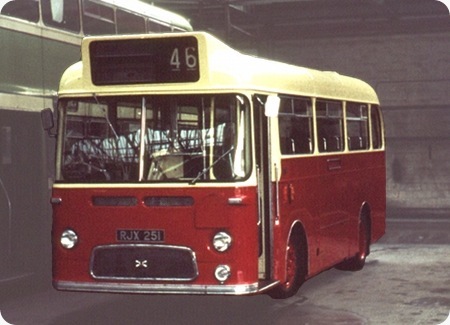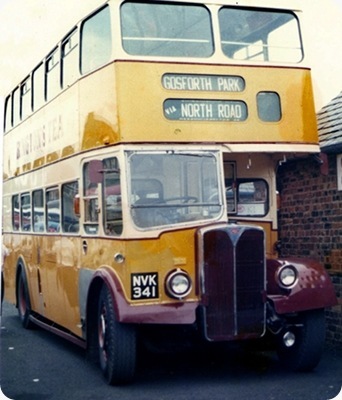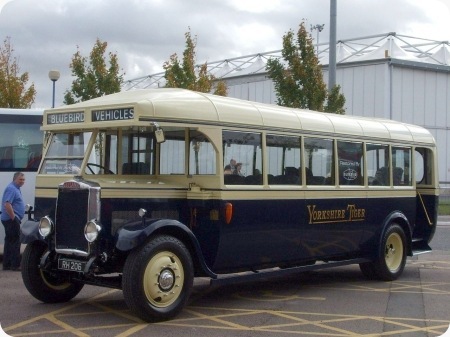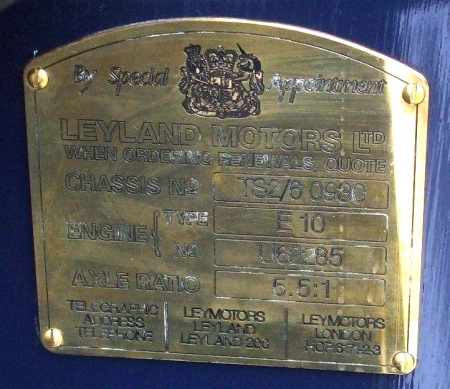
Copyright Roger Cox
Halifax Corporation Transport and Joint Omnibus Committee
1963
Albion Nimbus NS3AN
Weymann B31F
Here is a shot of Halifax Nimbus No. 251 in Elmwood Garage repainted for service with a new owner – I cannot now remember who that was. Despite its frailty and engine unreliability, I quite liked the little Nimbus.When I went to Halifax in 1964 I had only a motorcycle driving licence, and I learned to to drive on four (should that be six?) wheels during my lunch breaks. Initially I went out with the wonderful HPTD instructor, Arthur Brearley, in the old 1947 PD2 training bus, which, by then, had worn off most of its gearbox synchromesh, and I found this extremely heavy to drive. When this was not available one day, we had a Nimbus, and I took to this instantly. The six speed gearbox, apparently detested by most Halifax drivers, was easy to use with a light touch, which was essential if the middle gate was not to be missed. After passing my test, one of the routes I used to cover as a driver in the evenings was the 46 to Heptonstall, which, because of the unbelievably tight reversing point at the village – a narrow slot between two houses off an equally narrow road; even the mirrors had to be flattened against the bus to get in – a conductor was carried on the 31 seat Nimbus. The little Albion was certainly not up to the rigorous task of Yorkshire Pennine bus work, but it was a nice little thing to drive, and I renewed my acquaintance with the type some years later when I did a bit of moonlighting for North Downs Rural Transport.
Photograph and Copy contributed by Roger Cox
13/10/11 – 06:08
I know very little I’m afraid about the technicalities and operating realities of the Albion Nimbus – but I must say that this immaculate repaint to the order of a new owner says volumes about an operator who knows what a dignified livery is all about – its quite simply beautiful. If I didn’t know otherwise I’d say that it was heading for "The Garden of England" and the East Kent company in the good old days.
Chris Youhill
13/10/11 – 10:20
This vehicle was sold to Booth and Fisher, keen Albion Nimbus users. It survived to be taken over with that fleet by South Yorkshire PTE in 1976 and was even given PTE fleet number 1059.
253 of the batch was sold to Baddeley Brothers of Holmfirth and was still in the fleet when they were taken over by West Yorkshire PTE (as of course Halifax had been), although I don’t believe it was still in service.
258 was sold from a Joint Omnibus Committee to a municipality (Warrington), then to an Urban District Council (Ramsbottom) who in turn were absorbed into SELNEC PTE.
250 is still with us today, having spent many years working for Harvey’s at Mousehole. It survived long enough to be taken over by the post-deregulation Western National.
A batch of vehicles with a truly fascinating history!
David Beilby
13/10/11 – 11:39
256 also went to Baddeley Bros. Three others went to Wiles of (I think) Port Seton in E. Lothian but not sure which ones.
Eric
13/10/11 – 11:40
Another of the batch was sold to Wiles of Port Seaton near Edinburgh,I cannot remember what its number was.
Philip Carlton
13/10/11 – 11:42
Nimbus RJX 251 was sold to Booth & Fisher of Halfway near Sheffield. I believe it’s true to say that all or most of the Nimbuses were repainted by HPT for their new owners. For the record, they were disposed of as follows:
250: Harvey’s, Mousehole, Cornwall (now preserved).
251: Booth & Fisher, Halfway.
252: Wooliscroft (Silver Service), Darley Dale.
253/256: Baddeley Bros., Holmfirth.
254/257/259: Wiles, Port Seton.
255: Halifax Corporation Welfare Department (fitted with nearside wheelchair lift).
258: Warrington Corporation (later to Ramsbottom U.D.C, and then SELNEC)
I was still at junior school when these were delivered in 1963, and I well remember coming out of school after a school prize giving concert, and one turning up at the stop on the route 2 Northowram service. Not yet having discovered ‘Buses Illustrated’ I had no knowledge about what was happening in the bus world until I actually saw it, and the appearance of new buses was always unexpected and exciting.
I noted immediately the Albion badges, and the ultra modern curved windscreen – the first in the fleet and in total contrast to the earlier flat fronted Leopards and Worldmasters. Inside they were very tidy and bright, with flush light cream formica from floor to ceiling, instead of the usual MCW utilitarian painted metal.
As I took my seat, another Nimbus passed in the opposite direction, and as I got up to alight at Stump Cross another was turning into Kell Lane on the 33 to Shibden. They were everywhere !
Despite apparently having a four-cylinder version of the Tiger Cub engine, the sound effects were pure vintage Albion, sounding to me more like coal wagons. They had a characteristic nose down, tail up appearance, which seemed to increase with time.
Drivers always seemed to be struggling with them – especially the gearbox. They were hopelessly underpowered for the local mountainous terrain, though were capable of eventually getting up to a fair old speed on more level stretches. It was when they were at speed, especially coming down the hills and well loaded that the trouble really started. The brakes were apparently hopelessly inadequate and temperamental, and there were many heart stopping moments.
Although originally intended to provide feeder services from the various hilltop villages to the main road double deck routes, it just never really happened. They spent so much time in the workshops during the day being repaired and adjusted, that when they were released as available for service, usually during the afternoon peak, they just went out on to the next available duty, which would most likely have required something a bit more substantial. Consequently they were overloaded and thrashed unmercifully by drivers who hated them, and suffered as a result.
They were all sold off after three or four years and replaced by seven shortened, narrow Reliances with Pennine bodies.
I am surprised at Roger’s comments about enjoying driving Nimbuses, as all the older drivers I ever spoke to – without exception – detested them with a passion !
I also recall going on a transport society visit to Crich on a new Halifax Loline in 1967. We had arranged to call on Mr. Woolliscoft at Darley Dale to inspect his wonderful Silver Service fleet – including the withdrawn AEC Q-type. He had just acquired Nimbus 252 and it was parked in the back of his depot, nosed in towards the wall. We asked if it would be possible to bring it out to be photographed next to the Loline, and he agreed willingly. He climbed into its cab, started it up, and then attempted to select reverse. The bus lunged forwards towards the wall, and he hit the brakes – which fortunately worked on this occasion. He stirred the lever around and tried again – same result. And again, and again ! Finally, with the front panels almost touching the wall, and its owner red faced and cursing, it was decided that the only way would be for us all to push it out of the depot and across the road, and I think we then pushed it back !
I always found it difficult to believe that they had Weymann bodies. The were totally unlike anything the MCW companies had ever built, and one might have expected a sort of short, narrow version of the familiar ‘Hermes’ body similar to the Leopards and Worldmasters. Instead they were almost copies of the ones built by Harrington for Western Welsh. They were very neat looking vehicles.
I liked them though nonetheless, but then this was a few years before I became a driver, so I only experienced them as a enthusiastic passenger.
John Stringer
13/10/11 – 11:43
Albions – much neglected due to their early demise after their take over by Leyland in 1951. They should be remembered more fondly than perhaps they are, being side-lined into niches by Leyland. [The Aberdonian was a cheap light-weight version of a cheap light-weight version!!! ie of the Tiger Cub and was reviled as such.]
The Albion Victor VT21L was a Bedford SB13 clone with the Leyland 370 and a six speed gearbox. Generally regarded as much the superior beast, it was too expensive and too late to knock Bedford or Ford off their pedestals – and there were still Commer Avengers around. After this it was down hill all the way, although like the Leyland Panther, they still had success overseas where the home market didn’t work.
Booth and Fisher. A superb independent which ran by the end of my road on the Sheffield/Derbyshire border when I was a boy.
David Oldfield
13/10/11 – 17:05
When the Nimbuses were in service at Halifax, the bulk of the fleet consisted of Leylands, and changing gear with a PD2, even more so with a PD3, and exceedingly more so with the early Leopards, required the application of a certain degree of brute force. Also, it was not possible to miss the desired gate on the Leyland four speed synchromesh box. The six speed constant mesh Nimbus gearbox was the extreme opposite, and gear changing, which required double declutching, could be undertaken with the light pressure of a couple of fingers on the lever, and this was essential if the centre gate was to be detected. The gearstick did have rather long travel, and I have heard the characteristics of the Albion box described by unsympathetic persons as "stirring porridge with a knitting needle". The unpopularity of the Nimbuses was largely due to the total contrast of its light touch constant mesh gearbox with the heavier synchromesh boxes of the Leylands and AECs, or the even easier to drive AEC and Daimler preselectors.
Roger Cox
14/10/11 – 11:34
Was two of the batch painted in reverse livery and more comfortable seats for private hires.?
Philip Carlton
14/10/11 – 14:50
All the Nimbuses were delivered in conventional bus livery. The following year two Willowbrook-bodied Leopard DP’s arrived (269/270) which had the cream and orange areas reversed. Shortly after this Nimbuses 250 & 251 had their seats retrimmed with the same moquette as the Leopards and had headrests fitted. They were then repainted into the new DP livery. However, whereas the Leopards and later Reliance DP’s had polished metal trim above and below the central orange band, the Nimbuses had to have black lining painted on, as on the normal bus livery. On their withdrawal, some seats from both 250 & 251 were removed and fitted to new short Reliance replacement 252, though it was in bus livery. (The Nimbuses seated 31, but the Reliances seated 39). What was then used to reseat the Nimbuses for sale I do not know.
John Stringer
23/01/13 – 14:34

Sorry about the very late entry to this discussion about the Halifax Nimbi, but attached is a shot of 258 when it operated for Ramsbottam U.D.C.
I thought I had a shot of one of the other Halifax ones at Booth & Fisher, but it was one of the ex-Western Welsh ones.
Here in Australia the Nimbus was as successful as in UK, Rockhampton City Council in Central Queensland had six, 3 with Athol Hedges bodies and 3 bodied by Stewart & Sons of Bundaberg. They lasted into the mid-1970’s and a few saw further service with schools.
I’ll post a photo of the Ramsbottam one at the Stubbins Lane depot in 1969.
Ian Lynas
23/01/13 – 15:35
To see how unreliable these were just read the books by Geoffrey Hilditch who was responsible for them at Halifax. Aldershot and District borrowed one from Devon General and used it on their route 66 shadowed by one of their Falcons. They didn’t buy any!
Paragon
25/01/13 – 06:43
"PAYE" signs . . . you don’t see those anymore, do you? Halifax’s must have been amongst the more elaborate: an internally-illuminated glass covered by a drop-down flap – or as here, a slide down insert. At the time I thought YWD buses were very inferior with their black-on-yellow perspex flip-up/down boards behind the nearside windscreen – I think the KHD-series Leopards might have also had an illuminated PAYE sign to the rear of the entrance. The first time I saw a Leyland National (I) it had both its PAYE displays – to the left of the destination, and to the rear of the door – lit: wow! such modernity . . . and that I think was the last time I ever saw them in use. So: were these things ever a legal requirement, or just a passing fad? and if they weren’t a legal requirement why did operators spend so much cash specifying illuminated signs that were never used?
Philip Rushworth
25/01/13 – 12:33
Well, I guess at a time when PAYE was not universal (in fact quite unusual in urban areas) operators thought that signs (elaborate or not)might speed up the process if intending passengers were alerted to have their (hopefully correct) money ready as they got on. As we all know, that was a lost cause. Many city operators went over to "no change given" to save the time spent faffing about with change. And we are all familiar with the tedious process as a row of people board, each in turn putting his/her shopping, buggy and parcels down and then ferreting in the wallet, purse or handbag for cash, collecting the ticket, putting the wallet, purse or handbag away again and then collecting their worldly possessions together so that the pantomime could start all over again with the next "customer". (The essential of a passenger is that he travels. The essential of a customer is that he pays.) Of course twerly passes have speeded things up a bit – but not much.
Stephen Ford
26/01/13 – 06:28
See the posting of PMT 130 here PMT 130 for that Operator’s early design of Pay as you Enter sign on the front panel.
Ian Wild
 Vehicle reminder shot for this posting
Vehicle reminder shot for this posting
11/02/16 – 09:04
RJX 251 ended up after the stint with SYPTE as the Chesterfield Cricket Club tour bus. We at the club have just obtained a picture for the club house in Queens Park. Does anybody know what happened to RJX after it left our ‘care’
Vernon








